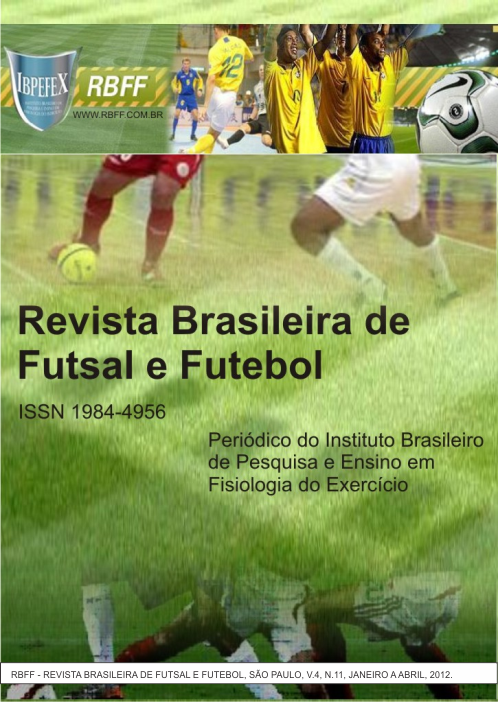Compararison of relative maximum oxygen uptake in football players teyween diferent categories of base in one club
Abstract
Objective of this study was to compare the maximum oxygen uptake (VO2max) on players that participates of three basis categories of a football club. Methodology: Study participants were 61 athletes from category basis of a football club professional. The athletes were divided into three groups, according to the chronological age and the category of football that competes; S13 (n = 23) age 12.5±0.7 and BMI 21.1±6.2, S15 (n = 19) age 14,5 ± 0.7 and BMI 18.45 ± 2.0; and S17 (n = 19) age 16.5 ± 0.7 and BMI 20.75 ± 2.0. It was determined the relative VO2max of athletes through the protocol of Bruce in treadmill until exhaustion.Results: The average VO2max on the group S13 of 55.87 ± 6.5 ml.kg.min, group S15 of 62.23 ± 7.6 ml.kg.min and group S17 of 68.14 ± 3.9 ml.kg.min. The S17 group showed significant differences (p <0.01) when compared with groups S13 and S15. Already the group S15 showed significant differences (p <0.01) when compared with S13. The data suggest that the category with higher chronological age of VO2max on larger.Conclusion:concluded from the results that the relative VO2max was higher in categories with higher chronological age, because of the greater time of practice and consequently higher volume of training and competitions.
References
-Aoki, M. S. Fisiologia, treinamento e nutrição aplicados ao futebol. Jundiaí, Fontoura, 2002.
-Balikian,P.; Lourenção, A. Ribeiro, L.F.P.; Festuccia, W.T.L.; Neiva, C.M. Consumo máximo de oxigênio e limiar anaeróbio de jogadores de futebol: comparação entre as diferentes posições. Revista Brasileira de Medicina Esporte, Vol. 8, Núm..2, 2002.
-Campiez, M,J. Análise de variáveis aeróbias e antropométricas de futebolistas profissionais, juniores e juvenis. Conexões, Vol. 2, Núm. 1, 2004.
-Leal Junior, E.C.P.; Souza, F.B.; Magini, M.; Martins, R.A.B.L. Estudo comparativo do consumo de oxigênio e limiar anaeróbio em um teste de esforço progressivo entre atletas profissionais de futebol e futsal. Revista Brasileira Medicinado Esporte, Vol. 12, Núm. 6, 2006.
-Mortatti, A.L. Arruda, M. Análise do efeito do treinamento e da maturação sexual sobre o somatotipo de jovens futebolistas. Revista Brasileira de Cineantropometria Desempenho Humano, Vol. 9, Núm. 1, p. 84-91, 2007.
-Santos, J.A.R. Estudo comparativo, fisiológico, antropométrico e motor entre futebolistas de diferente nível competitivo. Revista Paulista de Educação Física, São Paulo, Vol. 13, Núm. 2, p. 146–159, 1999.
-Stabelini Neto, A.; Mascarenhas, L.P.G.; Bozza, R.; Zampier, A.U.; Vasconcelos, I.Q.A.; Campos, W. Vo2máx e composição corporal durante a puberdade: comparação entre praticantes e não praticantes de treinamento sistematizado de futebol. Revista Brasileira Cineantropometria Desempenho Humano, Vol. 9. Núm. 2. 1p. 59-164, 2007.
-Villar, R.; Denadai, B.S. Potência aeróbia: efeitos do treinamento de futebol, idade cronológica e idade biológica em indivíduos de 10 a 15 anos do sexo masculino. In: Anais XII Congresso Brasileiro de Ciências do Esporte, 2001, Caxambu. Sociedade, ciência e ética: desafios para a educação física/ciências do esporte. 2001.
Authors who publish in this journal agree to the following terms:
- Authors retain the copyright and grant the journal the right of first publication, with work simultaneously licensed under the Creative Commons Attribution License BY-NC which allows the sharing of the work with acknowledgment of the authorship of the work and initial publication in this journal.
- Authors are authorized to enter into additional contracts separately for non-exclusive distribution of the version of the work published in this journal (eg, publishing in institutional repository or book chapter), with acknowledgment of authorship and initial publication in this journal.
- Authors are allowed and encouraged to post and distribute their work online (eg, in institutional repositories or on their personal page) at any point before or during the editorial process, as this can bring about productive change as well as increase impact and impact. citation of published work (See The Effect of Free Access).





